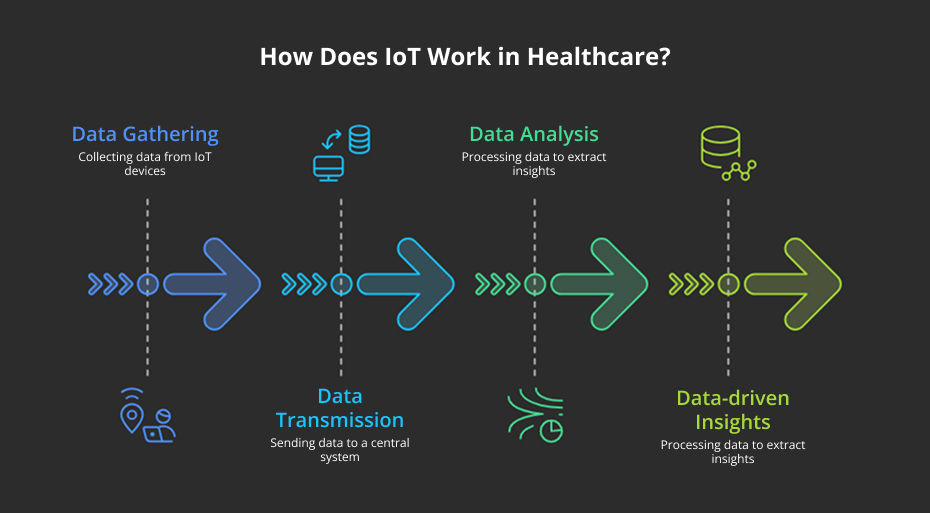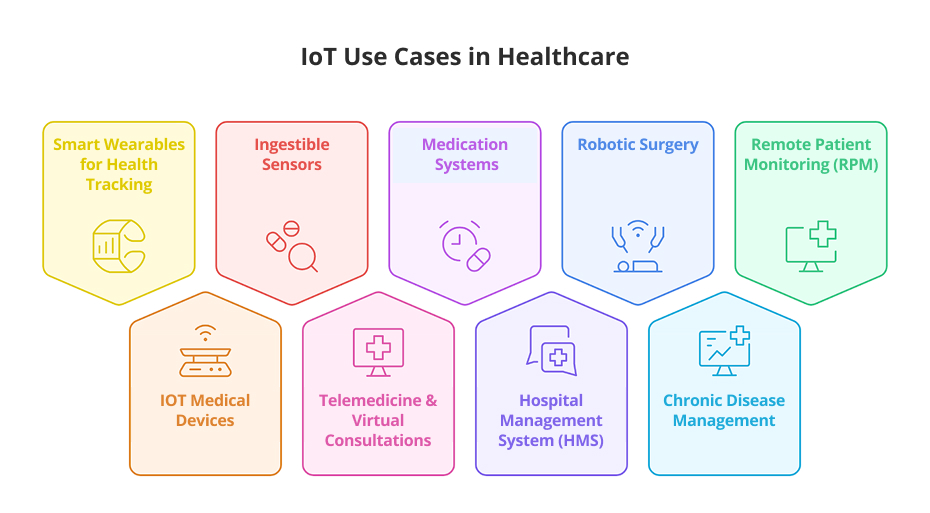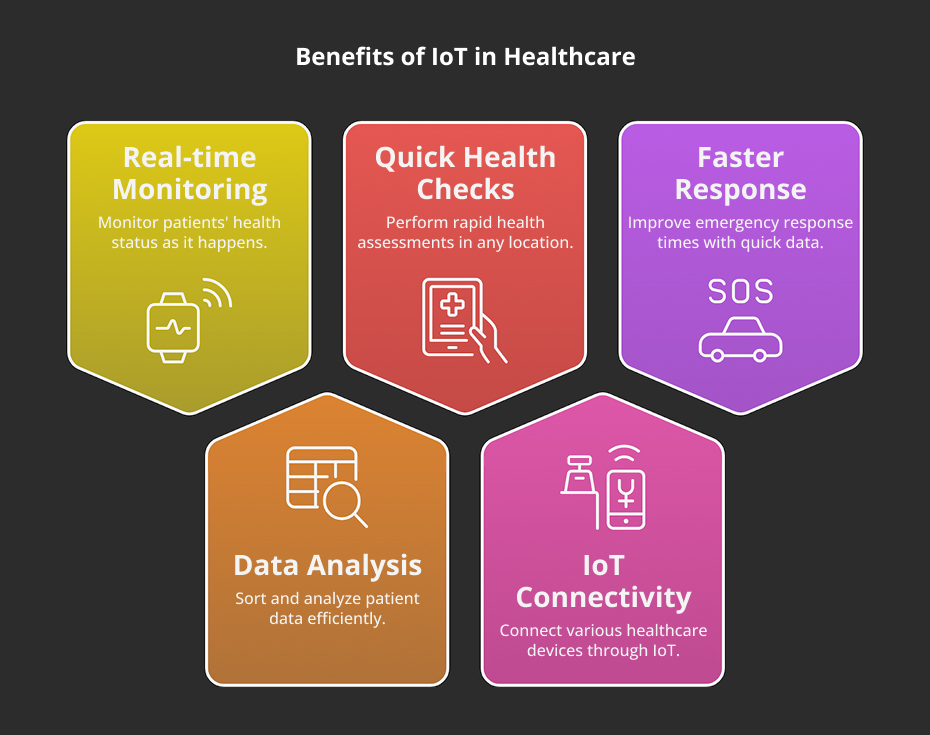The healthcare industry is under strain due to fragmented systems, rising healthcare costs, and delayed diagnosis, to affects patient outcomes. Surprisingly, 80% of healthcare data remains unstructured, while 20% of misdiagnoses stem from delayed or inaccurate information. This is where IoT in healthcare makes a measurable difference.
By connecting devices, systems, and data points across the systems, the IoT enables real-time patient monitoring, predictive analytics, and automates hospital workflow. This enables smart healthcare operations, improving medical decision-making.
Whether wearables tracking metrics or devices alerting doctors before operations, IoT is reshaping digital transformation in healthcare like never before.
This blog highlights the role of IoT in redefining healthcare and improving patient care.
How Does the Internet of Things in Healthcare Work?
The integration of advanced technology in every sector has raised the bar and improved the outcomes, including better efficiency, enhanced quality, and data-backed decision-making. Similarly, IoT in healthcare connects medical devices, like insulin pumps or wearables, to the internet for data collection and transmission. This aids in evaluating real-time metrics of a patient’s data and automates care as required.

But how does IoT aid in providing seamless communication between patients and healthcare providers? What is the process? To understand this, it’s essential to examine the role of IoT devices in healthcare and how they enhance the entire process. Here’s how:
-
Data Gathering
IoT medical devices gather complete healthcare data from patients by continuously monitoring them 24/7.
-
Data Transmission
The collected data is then securely sent to healthcare systems through encrypted channels for analysis.
-
Data Analysis
Healthcare professionals study the processed data to comprehend patient health and improve treatment effectiveness.
-
Data-Driven Insights
Providers utilize real-time data to make informed decisions and adjust treatments accordingly.
For example, a smart inhaler tracks asthma triggers and sends alerts to an IoT-powered healthcare mobile app that prompts patients to take necessary precautions. This integration empowers patients to manage their disease proactively, improving health outcomes.
Top IoT Use Cases in Healthcare
You must have comprehended how IoT in the healthcare industry works. Now, let’s explore the use cases of IoT in healthcare that are transforming this sector with smart healthcare solutions. From remote monitoring to robotic surgery, these applications of IoT in healthcare are taking patient care to a new level. By harnessing real-time data and modern technologies, healthcare providers deliver tailored treatments that aid in improving patient outcomes.

1. IoT for Remote Patient Monitoring (RPM)
Doctors can monitor the vital signs of patients through IoT monitoring solutions, like wearables or connected sensors. These aid in monitoring heart rate, oxygen levels, and other metrics, allowing timely interventions and improving patient care.
An implanted cardiac monitor sends arrhythmia alerts to clinics in real-time.
2.Smart Wearables for Health Tracking
IoT-powered wearables help individuals track fitness goals and manage chronic conditions, enabling early detection of potential issues. 92% of smartwatch wearers use wearable devices for health monitoring. Popular wearables integrate with healthcare systems for preventive care.
IoT in Healthcare Examples:
- Fitbit tracks activity and sleep
- Apple Watch detects atrial fibrillation
- Dexcom monitors glucose levels for diabetics
These examples showcase how IoT-powered wearables are shifting healthcare from reactive to proactive care.
3. IoT in Medical Devices
The advent of IoMT has transformed traditional healthcare practices into smart, connected tools that improve patient care. Devices like smart ventilators or infusion pumps reduce errors and enhance operational agility.
Examples of IoMT in Healthcare:
- Propeller Health tracks inhaler use for asthma management
- Medtronic ventilators reduce lung injury risks.
- BD Alaris prevents overdosage errors
These real-world applications highlight how IoMT is reshaping healthcare by enabling timely interventions, data-driven decisions, and safer treatments.
4. Ingestible Sensors
These are some of the most significant IoT use cases in healthcare. These tiny ingestible sensors monitor health issues from inside the body, tracking medication absorption and sending updates in real-time to doctors.
Proteus Digital Health tracks medication usage for schizophrenia patients, ensuring adherence, reducing relapse risks, and enabling timely interventions through real-time data shared with caregivers and clinicians.
5. Telemedicine & Virtual Consultations
IoT in telemedicine app development provides remote doctor consultations via video calls. Connected medical devices allow physicians to monitor patient health, diagnose, and prescribe treatments without in-person visits.
Teladoc is a telemedicine platform that integrates IoT devices, like blood pressure cuffs, into video calls to deliver remote patient care.
6. Medication Adherence Systems
Mobile apps benefit the healthcare industry in many ways. Businesses can integrate IoT in medical apps to remind patients to take medication on time and correctly.
Prominent IoT Examples in Healthcare include:
- Hero smart pill dispenser sends a reminder via app
- NovoPen tracks insulin dosage for diabetics
7. IoT in Hospital Management System (HMS)
The Internet of Things can be helpful in many healthcare operations. It can automate patient tracking, manage assets, and perform predictive medical equipment maintenance to reduce inefficiencies and improve care delivery.
GE Healthcare’s tags are one of the examples of IoT in healthcare that uses Real-time Location System (RTLS) to cut ventilator search time by 50%.
8. IoT in Robotic Surgery
IoT for robotic surgery enhances precision and minimizes risks. Surgeons control robotic arms remotely to ensure accuracy in delicate procedures while reducing recovery time.
Da Vinci Surgical System is a prominent example of IoT in healthcare, which performs complex procedures with greater precision and less invasiveness.
9. IoT for Chronic Disease Management
IoT in medical diagnostics helps manage long-term conditions by continuously monitoring symptoms and providing real-time alerts.
Cohero Health is alerting asthma patients about high pollen zones.
Key Benefits of IoT in Healthcare
Technology has upscaled mundane operations to smart healthcare outcomes. AI and IoT in healthcare have improved patient care and are evident in the use cases mentioned above. By gaining a crucial understanding of the advantages of IoT in medical sector, you can quickly scale the development of the IoT-connected healthcare app you are looking to build.

-
Real-Time Monitoring
IoT devices track vital signs, detect abnormalities, and send instant alerts to healthcare providers. This enables proactive care and helps manage chronic conditions more effectively.
-
Data Analysis
One of the striking benefits of the Internet of Things in healthcare is that it collects and analyzes vast amounts of patient data in real time. This data becomes even more powerful when paired with AI agents, helping doctors predict diseases, personalize treatments, and improve patient outcomes with precision.
-
Quick Health Checks
IoT solutions in healthcare, like wearables or remote patient monitoring devices, allow patients to check their health status from anywhere. This improves proactive care by reducing the need for frequent hospital visits.
-
IoT Connectivity in Healthcare
The Internet of Things facilitates seamless connectivity between devices to ensure smooth data exchange across hospitals and clinics. This way, smart healthcare solutions improve overall healthcare efficiency by minimizing errors and improving coordination.
-
Faster Emergency Response
The integration of IoT holds prominent importance in improving emergency responses. IoT-connected ambulances and emergency rooms provide patient data before arrival. This helps doctors prepare in advance and speed up life-saving interventions.
Essential Features of IoT Applications in Healthcare
IoT-powered applications in healthcare rely on data collection, AI-driven insights, and strong security measures. These ensure seamless patient monitoring, interoperability with existing systems, and scalable solutions for better healthcare outcomes.
-
Real-Time Data Collection
IoT devices in healthcare continuously collect patient data such as heart rate, glucose levels, blood pressure, and oxygen saturation. This real-time monitoring improves patient care through timely medical interventions.
-
Data Integration and Interoperability
IoT applications in healthcare can be integrated with Electronic Health Record Systems (EHRs) or more to facilitate seamless data sharing. This ensures that all healthcare professionals have access to updated and accurate patient information.
-
AI and IoT in Healthcare Apps
AI and IoT in healthcare analyze vast amounts of patient data to detect patterns, predict diseases, and recommend treatments. AI in healthcare enhances diagnostics, automates workflows, and helps doctors make data-driven decisions for personalized care.
-
Scalability using Cloud Computing
Cloud-based IoT healthcare solutions provide unlimited scalability, allowing hospitals to expand their digital capabilities without infrastructure limitations. Cloud storage ensures secure, remote access to patient data, making healthcare services more efficient and flexible.
-
Security and Compliance
Since patients’ data is sensitive, IoT applications in healthcare must have robust security features, like end-to-end encryption, secure data transmission, and compliance with industry regulations. Therefore, investing in HIPAA-compliant app development is crucial to ensure your data remains protected.
How to Implement IoT in Healthcare Facility?
Building a sophisticated application powering IoT in hospital management requires careful planning, secure infrastructure, and continuous monitoring. It’s a complex process; therefore, as a healthcare entity, you should take the assistance of an experienced IoT app development company to carry out the implementation process.
A structured approach ensures seamless integration, optimized performance, and compliance with industry regulations, leading to better healthcare outcomes.
1. Evaluate the Existing System (1-3 Months)
Before diving into IoT adoption, ensure to assess your existing system:
- Analyze your IT infrastructure, clinical workflows, and data storage systems
- Identify process inefficiencies and gaps that IoT can resolve
- Evaluate device compatibility and user readiness
This aids in finding gaps and determining the IoT healthcare solutions that align with medical workflows to enhance agility.
2. Plan Strategy and Set Goals (1-2 Months)
After that, clearly define objectives. What do you want from IoT-based solutions such as remote patient monitoring, VR in healthcare, or hospital automation? Setting measurable goals ensures IoT adoption aligns with healthcare needs, enhances patient care, and delivers cost-effective results.
3. Build a Strong Network Infrastructure (3-6 Months)
A seamless experience of IoT applications in healthcare depends on a robust technical foundation:
- Upgrade to high-speed and low-latency connectivity
- Deploy edge computing nodes to handle real-time analytics
This enables secure interoperability between IoT devices, hospital databases, and EHR systems.
4. Ensure Security and Compliance (2-4 Months)
Implement encryption, multi-factor authentication, and regular audits to protect patient data. Adhering to regulatory standards like HIPAA, GDPR, and FDA guidelines ensures data integrity and legal compliance.
5. Build and Test IoT Solutions (6-12 Months)
A skilled professional will build a prototype before deploying IoT-powered mHealth apps at scale:
- Develop and simulate conditions in controlled environments.
- User acceptance testing with real healthcare staff.
- Stress-test device connectivity, data handling, and response time.
This ensures a smoother adaptation phase by improving the overall trust of healthcare teams and patients.
6. End-to-End Development (3-6 Months)
Develop IoT applications with user-friendly dashboards, AI-driven analytics, and cloud compatibility. A well-structured development phase ensures long-term sustainability and efficiency in healthcare operations.
7. Monitoring and Improvement (Ongoing)
IoT in healthcare requires continuous monitoring to detect faults, optimize performance, and prevent cyber threats. Regular updates and AI-driven predictive maintenance enhance system efficiency and data accuracy.
Evaluating the Cost of Implementing IoT in Healthcare
The cost of IoT in healthcare fluctuates. It depends on the hardware used, software type, cloud infrastructure, compliance, and integration complexity. However, the estimated cost of IoT implementation in healthcare typically ranges between $30,000 to $300,000+.
Several factors, such as device type, data storage needs, and AI capabilities, influence the total cost to develop a healthcare app. A well-planned strategy ensures cost efficiency and maximum ROI.
Key Cost Components
Initial setup can be pricey, but long-term savings from better patient management are substantial. It’s an investment that can benefit hospital owners, professionals, and investors in the long run. Some of the key cost components to consider while curating IoT healthcare solutions include:
- IoT devices and sensors
- Connectivity infrastructure
- IoT software platform
- Cloud storage and processing
- EHR & EMR integration
- Security and compliance
- Training and change management
- Ongoing support and maintenance
Approximate Cost Range of Internet of Things in Healthcare
The cost of integrating IoT technology in the healthcare industry differs based on the way it is implemented. Here is a tabular representation of the cost one must invest to perform this:
Implementation Scale | Estimated Cost |
| Small Clinic (Single Use Case) | $25,000–$55,000+ |
| Medium Hospital (Multi-Use Case) | $60,000 – $140,000+ |
| Large Network or Smart Hospital | $145,000 – $2 million+ |
Note: These figures are just indicative and can be more or less based on the geography, vendor scope, and customization needs.
Common IoT Healthcare Implementation Challenges
While IoT in healthcare offers several benefits and features, it also comes with mounting challenges like security risks, integration issues, and compliance hurdles. In this section, we will discuss the implementation challenges of IoT in healthcare that can deter seamless adoption.
-
Data Security & Privacy
IoT devices generate vast amounts of sensitive patient data, making them prime targets for cyberattacks.
-
Integration with Multiple Devices & Protocols
Different IoT devices in healthcare use various communication protocols, making seamless integration challenging.
-
Data Overload & Accuracy
Massive volumes of patient data can overwhelm healthcare providers, leading to misinterpretation or delays in decision-making.
-
Regulatory Compliance
Smart healthcare solutions must adhere to strict regulations like HIPAA, GDPR, and FDA guidelines.
-
Costs Involved
Implementing IoT in healthcare involves significant investment in hardware, software, security measures, and infrastructure upgrades.
How to Tackle IoT Challenges in Healthcare Effectively
IoT technology in healthcare faces challenges like security risks, data overload, and integration issues. Overcoming these challenges requires 5G connectivity, AI-driven diagnostics, and personalized medicine for seamless operations and better patient outcomes.
1. Encrypted Data Security
It is crucial to safeguard patient data by following metrics, like:
- Multifactor authentication
- Implement end-to-end encryption
- Blockchain technology for complete transparency
- Regular security audits
- Real-time threat detection
Implementing these measures in IoT-powered smart healthcare solutions will aid in preventing cyberattacks and ensure data privacy.
2. Seamless Protocol Integration
Adopting FHIR, HL7, and MQTT protocols ensures interoperability between IoT devices and healthcare systems. Hire IoT developers who will use cloud-based APIs to further simplify data exchange and enhance system compatibility.
3. AI-Powered Data Management
AI-powered analytics filter and prioritize relevant patient data, reducing unnecessary alerts. Edge computing processes data locally, ensuring only essential information is sent to healthcare providers, improving accuracy and efficiency.
4. Automated Regulatory Compliance
Implement HIPAA, GDPR, and FDA-compliant security frameworks. Automating compliance tracking, maintaining audit logs, and conducting regular assessments to ensure adherence to healthcare regulations and avoid legal risks.
Trends to Watch for IoT in Healthcare
The future of the Internet of Things in healthcare is advancing significantly with AI-driven diagnostics, edge computing, and more. These aid in improving patient care by optimizing hospital operations and creating a more concerned healthcare ecosystem.
-
5G Impact on Healthcare IoT
The impact of IoT in healthcare through 5G aids in improving low-latency through ultra-fast connectivity. This will improve real-time healthcare operations, like robotics surgeries or telemedicine services. Better connectivity improves patients’ data visibility.
-
Edge Computing for Reduced Latency
Edge computing processes data closer to the source, which reduces delays and bandwidth dependency. This ensures real-time decision-making in critical applications like ICU monitoring and wearable health devices.
-
AI-Driven Predictive Diagnostics
One of the key IoT healthcare trends is predictive diagnostics. AI-powered IoT devices analyze patient data to detect early signs of diseases. By identifying potential health risks before symptoms appear, smart healthcare solutions enhance preventive care and reduce hospitalization rates.
-
Blockchain for Secure Health Data Exchange
Blockchain enhances security by creating tamper-proof, decentralized health records. It ensures safe data sharing between providers while maintaining patient privacy, reducing fraud, and improving compliance with healthcare regulations.
-
Personalized Medicine
IoT and AI provide customized treatment plans based on individual patient data, genetic factors, and real-time health tracking. This approach enhances medication effectiveness, reduces side effects, and improves long-term health outcomes.
How Can SparxIT Help You Integrate IoT Technology in Healthcare?
SparxIT has expertise in seamless IoT integration for healthcare. As a leading healthcare app development company, we offer custom solutions that can be easily integrated into your apps, smart wearables, and other connected IoT devices. Apart from that, we believe in secure and transparent data management. Our expertise in AI, cloud computing, and blockchain ensures a future-ready healthcare system.
We focus on HIPAA-compliant app development, interoperability, and real-time analytics to enhance patient care and operational efficiency. We deliver scalable, cost-effective IoT solutions tailored to your healthcare needs from strategy to deployment.

Partner with Experts
Frequently Asked Questions
How much does it cost to integrate IoT into healthcare systems?







IoT integration costs vary based on device complexity, software development, security measures, and cloud infrastructure. A basic system may start at $30,000, while advanced, AI-powered solutions can cost $300,000, depending on scalability.
What are the challenges of IoT in healthcare?












Key challenges include data security risks, device interoperability issues, high implementation costs, and regulatory compliance. Ensuring HIPAA/GDPR compliance, robust cybersecurity, and seamless integration is crucial for successful IoT adoption in healthcare.
What are the common use cases of IoT in hospitals and clinics?












The use cases of IoT in hospitals and clinics include remote patient monitoring, smart ICU management, real-time asset tracking, predictive maintenance of medical equipment, and more. These improve healthcare operations’ efficiency by reducing manual errors.
How does the Internet of Things in healthcare enhance patient outcomes?












Applications of IoT in healthcare improve patient outcomes through real-time monitoring, early diagnosis, and data-driven treatment plans. This way, doctors take timely decisions by reducing hospital readmissions.
Which companies provide the best IoT healthcare solutions?












Many companies in the market provide healthcare solutions powered by IoT. The best one depends on your specific project needs. However, you can contact us to build top-tier IoT healthcare solutions that precisely relate to your needs.




